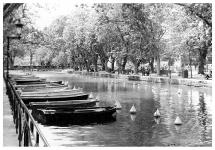|
Joux Steno-Jumelle |
Manufactured or assembled in France from (Before) 1896 to (After) 1903.
Index of rarity in France: Rare (among non-specialized garage sales)
Inventory number: 13539
See the complete technical specifications
Chronology of cameras Joux
En plus de la gravure en façade qui identifie clairement cette "Sténo-Jumelle" de L. Joux (elle porte le numéro 263), une seconde gravure sur le bloc obturateur/optique montre le logo des frères Pipon et la mention "Constructeurs".
A la différence des illustrations reproduites, la mise au point se fait par un levier à cinq positions, de 2 mètres à l'infini, levier en tous points semblable à celui qu'on trouve sur le "Self Worker" de Pipon.
Le nom Sténo-Jumelle est déposé le 6 février 1895. Il en existe trois variantes ainsi qu'une version stéréoscopique. La version de cette page est la dernière. Le corps et le magasin avaient fait l'objet d'un brevet (n° 239019) en date du 4 juin 1894.
Le paragraphe "Description" donne d'amples explications sur le modèle. Un détail intéressant : on ne peut armer l'appareil sans la mise en place d' une nouvelle plaque.


Presentation excerpted from l'Annuaire de la Photographie . 1898.
To Photography Enthusiasts,
Jumelle-style cameras undeniably offer significant advantages over cameras known as "detectives." Besides a noticeable difference in size, they provide the benefit of a more rational viewfinder. Indeed, with detectives, aiming is done through reflection, which cannot achieve perfect precision. Furthermore, since the lens is positioned at roughly waist level, it results in a shallow perspective, whereas when taking a photograph, it is essential to have a commanding view of the subject. With jumelles equipped, like ours, with a clear viewfinder and direct aiming, you can capture images that closely match what the eyes have seen.
Eager to contribute to the ongoing advancements in photography, we have introduced improvements in the construction of the cameras, now widely recognized as "Steno-Jumelle," each year. The specialized workshops we have organized have allowed us to further refine our program and, finally, provide our customers with a definitive model of indisputable superiority.
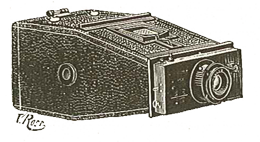 Due to the exclusive use of metal (aluminum and copper) in the manufacturing of Steno-Jumelle, production can only be entrusted to precision engineers. This results in significant advantages in terms of durability and functionality for these cameras.
Due to the exclusive use of metal (aluminum and copper) in the manufacturing of Steno-Jumelle, production can only be entrusted to precision engineers. This results in significant advantages in terms of durability and functionality for these cameras.
It is important to understand that temperature fluctuations or variations in humidity, which can be detrimental to thin wooden cameras in our regions and near the coast, have no impact on a metal instrument. The adjustment and sealing of these cameras offer the most explicit guarantees under these conditions. The volume is even further reduced, and the weight has not increased.
The system has always remained very simple, so enthusiasts, especially those who travel extensively, do not have to fear accidents that would deprive them of the use of their camera. What has always characterized Steno-Jumelle is that, despite their ultra-compact size, they are adaptable to all photographic combinations one might encounter, without the need for additional accessories. The list provided below will provide information about this highly appreciated versatility by tourists.
In addition to the improvements we have just mentioned, our workshops have recently completed a stereoscopic jumelle that is in no way inferior to its predecessors. The difference in size with similar cameras is even more noticeable in this new model, which presents itself as lightweight and elegant, with very few external components.
 Nevertheless, it is as complete as possible, encompassing the same advantages as other Steno-Jumelle.
Nevertheless, it is as complete as possible, encompassing the same advantages as other Steno-Jumelle. 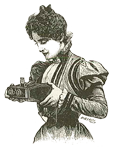
For a long time, this construction had been requested of us. The thorough studies it has led to have left us with the conviction that it will provide the utmost satisfaction to stereo photography enthusiasts.
Description
Steno-Jumelles are recommended for the following advantages:
1. Minimum volume and weight.
2. A new, simple, and quick retractable system consisting of two chambers, with one fitting inside the other. When these two chambers expand, the exposed plate, left to its own cameras, falls to the bottom and moves behind the others when the camera is closed.

3. Anastigmat lenses:
- Zeiss, Series IIa 1:8 F/110 mm for 6.5 x 9 format.
- Zeiss, Series IIa 1:8 F/136 mm for 9 x 12 format.
- Goerz (*) Series III 1:7.7 F/110 mm for 6.5 x 9 format.
- Goerz (*) Series III 1:7.1 F/130 mm for 9 x 12 format.
4. Iris diaphragm.
5. Optional focus adjustment from infinity (∞) to 1.50 m for the 6.5 x 9 format and 2 m for the 9 x 12 format.
6. Shutter (new improved patented S. G. D. G. model) of the guillotine type placed at the rear of the lens, evenly exposing all parts of the plate. It can be cocked without being uncovered and allows for instantaneous exposures with variable speeds or time exposures. It can be triggered at will using a button or a rubber bulb. The arrangement of the shutter blades applied immediately against the rear wall of the shutter prevents dust and glass debris from entering the interior of the mechanism.
7. "BLOCK-SYSTEM" automatic feature (Patented S. G. D. G.) prevents double exposure of the same plate.
8. Automatic counter displaying the number of the plate ready to be exposed after each retraction.
9. Clear viewfinder and aiming point that disappears into the thickness of the camera when not in use.
10. Congress thread allowing the STENO-JUMELLE to be mounted in either direction on any tripod.
(*) The Goerz lenses we use are specially designed for the STENO-JUMELLE.
Instruction
Loading
 OPERATION TO BE PERFORMED IN THE DARKROOM:
OPERATION TO BE PERFORMED IN THE DARKROOM:
1. Set the counter to display the number 1 by retracting the camera without a plate as many times as necessary.
2. Open the magazine cover by moving the locks in a direction perpendicular to the bottom of the camera.
3. Load the plates into the holders with the emulsion side facing outward.
4. Place the holders in the magazine in numerical order, after brushing the plates with a brush to remove dust beforehand.
5. Close the magazine by returning the locks to their original position.
The STENO-JUMELLE, loaded in this manner, is ready to operate.
Focusing
Depending on the distances of the subjects to be photographed, you will need to adjust the focus. Changes in focal length are made by manipulating the knurled ring A of the lens in one direction or the other so that the small mark B aligns with the number representing the distance in meters. The estimation can be approximate for distant objects but should be more precise as you get closer.
Under no circumstances should you attempt to unscrew the two small buttons C and C' located on the lens tube; doing so could disrupt the camera's settings.
Diaphragms
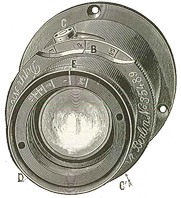 For snapshots, you should generally use the large aperture to maximize light intake, with a few exceptions. In very bright conditions, near the sea or in the mountains, you can occasionally use aperture division #1 and sometimes #2. Conversely, for long exposures, it's advisable to use the smaller diaphragms to achieve greater sharpness and depth.
For snapshots, you should generally use the large aperture to maximize light intake, with a few exceptions. In very bright conditions, near the sea or in the mountains, you can occasionally use aperture division #1 and sometimes #2. Conversely, for long exposures, it's advisable to use the smaller diaphragms to achieve greater sharpness and depth.
To adjust the aperture setting, you can manipulate the ring D, located on the front of the lens, either to the right or to the left, so that the reference point E aligns with the chosen division.
The relationship between exposure time and aperture numbers is based on the following principle adopted by the Congress. The lens rings are labeled with numbers 3/5, 1, 2, 4, 8, 16. The number 3/5, which represents the large aperture, corresponds to 1/8 of the focal length, while number 1 corresponds to 1/10, constituting the basic exposure unit. For instance, if at 1/10 of the focal length an exposure required one second (this is just a comparison term), then at any aperture setting, it would be 3/5 of a second at aperture #2, two seconds at aperture #4, and so on, with each division doubling the time of the preceding one.
Instantaneous Exposure:
1. Use the slider C to reveal the letter I (instantaneous).
2. Cock the shutter by using button A to pull the attached rod all the way out and allowing it to retract by itself. At this point, a small index E appears below this button, indicating that the shutter is cocked. If you only partially pull the rod, you risk uncovering the lens.
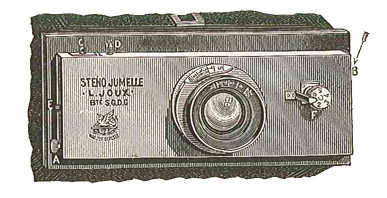 3. Using the clear viewfinder, aim at the subject you want to photograph. To ensure a well-centered image, whether the shot is in portrait or landscape orientation, align the small disc of the point of aim needle with the intersection of the two red lines dividing the lens, and the center of the subject to be photographed.
3. Using the clear viewfinder, aim at the subject you want to photograph. To ensure a well-centered image, whether the shot is in portrait or landscape orientation, align the small disc of the point of aim needle with the intersection of the two red lines dividing the lens, and the center of the subject to be photographed.
4. Finally, gently press the trigger D, which activates the shutter. Make sure to perform this action smoothly and without jerking; this will expose the plate. The knurled wheel F is used to adjust the shutter speed for instantaneous shots; the divisions marked on it indicate the various speeds, with the slowest being labeled as number 1.
Time Exposure:
1. Use slider C to reveal the letter P (pose).
2. Set the knurled wheel F to number 1, which corresponds to the lowest speed.
The shutter is cocked as in instantaneous mode. To trigger the exposure, you could use your finger, but it's better to use our rubber bulb equipped with a small pump that screws onto the trigger. A first press uncovers the lens, and a second press closes it. However, since it's impossible to maintain complete stillness during the exposure, no matter how short it may be, the camera should be placed on a support. In this regard, we highly recommend our specially designed Tripod-Canne for the STENO-JUMELLE.
Retracting the Plate:
When the plate has just been exposed, you must retract it. To do this:
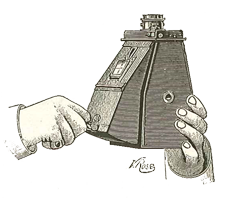 1. Hold the camera with your left hand, with the lens pointing vertically towards the sky.
1. Hold the camera with your left hand, with the lens pointing vertically towards the sky.
2. Grasp the ring of the movable frame with your right hand.
3. Pull the movable part firmly and all the way until you feel a stop; at this point, pause briefly to allow the frame to complete its fall.
4. After hearing the plate fall, push back the movable frame and fold down the ring. It is then that you can cock the shutter again, which, thanks to the automatic "BLOCK-SYSTEM," would resist if the plate had not been changed.
There may be cases where this pause would be inconvenient. For example, if you forget to simulate the retraction before loading the camera, with the shutter previously locked; or when you have operated by mistake while leaving the lens cap on, which would require retracting an unexposed plate. To free it without changing the plate, simply pull back and then push forward the slider B of the Block-System, which is located on the left side of the camera.
Under no circumstances can the camera be rendered inoperable due to an incorrect retraction maneuver. If changing a plate does not proceed smoothly and prevents you from closing the drawer completely, which could happen if you tilt the Jumelles too far back, simply repeat the retraction movement while keeping it upright this time. The plate will complete its cycle without causing a second frame to advance, thanks to the claw guidance system.
Unloading the Camera
Open the magazine. Hold the camera in your right hand, invert it over your left hand, and give it a gentle shake, causing the frames to 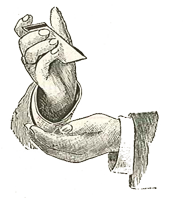 partially emerge. You can then easily remove them. To extract the plates from their frames, hold the frame with your right hand by the edges, as shown in the figure below, then briskly strike the palm of your right hand against your left hand; the plate will protrude a few millimeters, enough to remove it entirely. In any case, avoid touching the gelatin with your fingers, as this could result in stains on the photographs.
partially emerge. You can then easily remove them. To extract the plates from their frames, hold the frame with your right hand by the edges, as shown in the figure below, then briskly strike the palm of your right hand against your left hand; the plate will protrude a few millimeters, enough to remove it entirely. In any case, avoid touching the gelatin with your fingers, as this could result in stains on the photographs.
Note: Never operate the retraction mechanism without the frames being loaded with plates.
Interesting links or bibliography :
| Sur Camera-wiki.org, suggested by Sylvain Halgand |
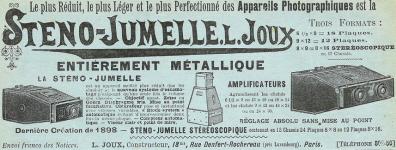 La Nature de 1899 |  Bulletin du Photo-club de Paris de 1895 |
Add a link or element of bibliography, a picture taken with this camera, a picture of box or an ads about this camera
Your photos taken with the same camera:
Cameras from Ebay France (Joux) (Uploaded each 3 hours)
 Appareil Photo-Pochette L Joux Paris SGDG 9x12 Bois gainé Stheinhel Orthostigmat 380,00 euros Finira le 26-05-2024 à 17:11:40 |







